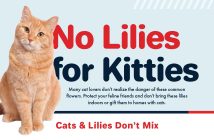by Marie Rizzuto
Last year, I was caught by surprise and embarrassment when I was told that my canine best buddy, Dreyfuss (Dre), was a few pounds overweight. Being a proud pet parent who loves every bit of my pooch, it was hard for me to acknowledge his weight gain. His vet kindly pointed out that his waist had become difficult to distinguish. (According to my vet, most dogs should have a distinguishable waistline). I realized that it was caused by a combination of things—mainly, excessive snacking and a decrease in physical activity.
After about six months of implementing a more disciplined lifestyle, which consisted of a significant decrease in snacks, a dog food that was higher in protein and lower in carbohydrates, and an increase in exercise, Dre reached his goal weight. Dre even received a standing ovation from his vet and two staff members, which definitely made his tail wag. While creating a healthier lifestyle for Dre, I researched pet obesity further and found out many things that I’d like to share with the rest of you.
Obese and overweight dogs and cats have become a common phenomenon among many homes. Despite how cute a pudgy little belly may seem on a cat or how adorable a few extra ripples can be on a puppy, pet obesity is a serious issue that has led to an increase in pet health complications, along with a decrease in the quality of life for many pets. Over half of the nation’s dogs and cats are obese, according to a 2011 study conducted by the Association for Pet Obesity Prevention (APOP) in conjunction with Banfield, the nation’s largest veterinary clinic chain.
Defined as pets that weigh 30% more than their normal weight, obese pets are more likely to develop health conditions, such as high blood pressure, Type 2 Diabetes, kidney disease as well as even heart and respiratory conditions. Meanwhile, overweight and obese pets are more likely to develop issues that may hinder mobility, which only perpetuates their extra weight. Furthermore, the physical conditions associated with being overweight or obese have not only been attributed to lowering the quality of life for many pets, but pet obesity has also been found to shorten the lifespan of many dogs and cats.
The good thing is that pet obesity can be prevented! Just as I had done to help Dreyfuss reach his goal weight, there are things that you (as a pet parent) can do to prevent your pet from becoming overweight or obese.
- Pet Breed Research. As many dog and cat breeds vary in propensity to gain weight, it’s always wise to learn more about your pet’s background to determine the exercise regimen and meal choices that are best for your furry friend.
- Well-Proportioned Pet Meals. Read the label on your pet’s food and use measuring cups to ensure that you’re feeding your pet the recommended daily amount. While it seems easier to grab a few handfuls or quickly pour a certain amount of food into your pet’s bowl, giving your pet either too much or not enough food will greatly affect your pet’s health. If your pet is overweight, obese or has other health conditions, consult your veterinarian to determine the best daily amount of food for your pet.
- Healthy Pet Food. Take advantage of the plethora of pet foods available to determine the type of food that is best for your pet. Read the ingredients so that you know exactly what they’re eating. Many dogs and cats have certain food allergies, so it’s best to give your pets food that do not contain any ingredients or food sources they may be allergic to or may have a hard time digesting.
- Excessive Pet Snacking. Like many pet parents, I had a tendency to give Dreyfuss too many snacks throughout the day. In addition, I let others give him a lot of snacks too. While snacks make pets very happy, the consumption of excessive snacks causes weight gain, which can lead to pet obesity. Monitor the amount of snacks your pet receives each day to ensure that it doesn’t exceed a sensible amount. For pets that are training and are rewarded with snacks, break bigger snacks into smaller bits or use snacks that have been developed for training, as they tend to be smaller in size.
- Pet Exercise. Pets need a certain amount of physical stimulation each day in order to stay fit and maintain healthy bones and muscles. Whether it’s taking your dog out for regular walks, running with your dog or physically stimulating your cat with various teasers and cat toys, make sure that your pet engages in physical activity on a regular basis. Be sure to ask your vet about the recommended amount of physical activity for your dog or cat.
While pet obesity is a prevalent issue that can severely affect your pet’s overall health, quality of life and lifespan, it can be prevented. Dreyfuss may not have been part of the statistic, but he may have been had I not done something about it. Do your part as a caring and responsible pet parent to prevent pet obesity. Give your pets the good and happy life they deserve by preventing them from becoming overweight or obese.

After growing up in a Southern California household with exotic birds, tropical freshwater fish and dogs, Marie Rizzuto developed a passion for rescuing animals. In her spare time, Marie enjoys hiking, surfing, reading, lounging around with her dog and sharing her experiences, opinions and research on pet care through blogging and actively posting on pet forums. Marie works for PETCO and teaches communication courses at local community colleges. Contact Marie.




9 Comments
Thanks for the great article Marie. I do take my Blue Healer to the dog park most days. He loves to run and run and run. Keva is only 2 and a half years , yet he is the fastest dog there!! People there say I should enter him in races and that he is faster than a Grey Hound!!!
Thanks for reading the article Catherine! After dealing with Dre’s weight gain and loss, I just felt compelled to share what I had learned with others. I’m glad to hear that Keva is a fast runner and loves to run. I wish Dreyfuss shared the same zest for running, but he’s more of a couch potato. That’s why I’ve had to really make an effort to get him to engage in more exercise. With regard to Keva’s speed, have you considered having him compete in agility? Who knows?… Maybe Keva might be a natural at it too!
This is so true! I know that, in the past, I have simply filled the food bowl whenever I see that it is empty; this is a bad idea! Not only was this too much food, but the food itself was not healthy. From what I have been able to tell, the vast majority of the dog food out there contains a large amount of ‘cereal’; this provides too many carbohydrates and not enough fiber or protein – a definite aid towards obesity. A good test to see what percentage of your dog’s food is ‘cereal’ is to soak the dog food in water; if the food swells up to 2x larger or more, there is an overwhelming amount of ‘cereal’ in the food.
Try a different dog food like Purina One; it has a good percentage of protein and fiber, as well as essential vitamins/minerals. It’s not super cheap, but worth it! You can almost always find good coupons for that brand; a good place to find pet food coupons and store deals is couponingforpets.com
Wow this is such a great article, Thanks for sharing it. I probably need to watch skip’s diet from now on. My dog is a terrier and he loves to eat, and sometimes becomes lazy when he is full. I wonder what to do with him. Should I take him to a veterinarian to check his health.
Thanks so much for taking the time to read it! Yes, it’s always a good idea to have your vet take a look at your terrier just to determine whether or not he’s at his ideal weight… especially if he’s been acting differently (lazy or lethargic) than normal.
What a decadent age we live in, America’s pets are facing an obesity epidemic, while thousands of people are starving in Africa.
Our 14 year old tom cat used to be obese when I first joined his household. After a couple of years, he became an outdoor cat. After the contaminated cat food scare a few years back, I changed his diet from dry cat food to raw chicken breast, chicken gizzards, hearts, and liver, and tuna with garlic, plus a little dry food for dessert. He is now a sleek and energetic brawler, who stays out all night and can run like the wind.
Thanks for the article, I’m actually dealing with an overweight dog myself. Currently, I’m taking steps to help him out. Things like more exercise, healthier foods, and feeding him the appropriate amount of pet food each day should definitely lead him to a healthier life.
I really enjoyed this article! I know how dogs and cats have different nutritional needs, but didn’t realize how different breeds have particular needs as well.
Determining healthy pet food is often easier said than done, however. I would argue that the percentages of moisture can be more important than just reading the ingredients. For example, canned food with 8% crude protein and 75% moisture actually has more physical protein than dry food with 27% crude protein and 10% moisture. The FDA suggests comparing dry and canned product content by multiplying the guarantees of canned products by 4.
If anyone wants some more info on pet care, check out my latest blog posts: http://mjenee.wordpress.com/
Nice post! I like to snack so it’s hard to tell my pup he can’t snack too 🙂 One thing you can do to promote better gastrointestinal health, therefore better weight management, is a pet probiotic such as Fortiflora. The other ideas are great as well, many of which would work for pets and humans alike!